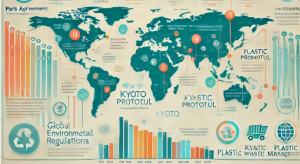In recent years, environmental regulations have become an increasingly critical factor in business planning and strategy. As governments worldwide intensify efforts to combat climate change and protect natural resources, companies across industries are finding themselves at the intersection of compliance, innovation, and competitive advantage. This article explores the evolving landscape of environmental regulations, their impact on business strategy, and how forward-thinking organizations are turning regulatory challenges into opportunities for growth and sustainability.
The Evolving Regulatory Landscape
Environmental regulations have come a long way since the early days of pollution control measures. Today, they encompass a wide range of issues, from greenhouse gas emissions and energy efficiency to waste management and biodiversity conservation.
In the United States, the Environmental Protection Agency (EPA) continues to refine and expand its regulatory framework. The Clean Air Act and Clean Water Act remain cornerstones of environmental protection, but newer initiatives like the Clean Power Plan aim to reduce carbon emissions from power plants significantly.
Across the Atlantic, the European Union has taken a leadership role in environmental regulation with its ambitious European Green Deal. This comprehensive policy framework seeks to make the EU climate-neutral by 2050, affecting everything from energy production to transportation and agriculture.

Meanwhile, developing economies are also stepping up their environmental efforts. China, for instance, has implemented stringent air quality standards and is investing heavily in renewable energy. India has set ambitious targets for electric vehicle adoption and solar power generation.
These regulatory developments are not occurring in isolation. International agreements like the Paris Climate Accord have created a global framework for environmental action, encouraging countries to set and meet increasingly ambitious targets.
Impact on Business Strategy
For businesses, this evolving regulatory landscape presents both challenges and opportunities. Compliance with environmental regulations is no longer just about avoiding fines or negative publicity – it’s becoming a core component of business strategy and a potential source of competitive advantage.

Many companies are finding that environmental compliance drives innovation and efficiency. For example, stricter energy efficiency standards have led to the development of new technologies and processes that not only reduce environmental impact but also lower operating costs.
Risk management has also taken on a new dimension in light of environmental regulations. Companies are increasingly factoring in regulatory risks when making long-term investment decisions. This includes assessing the potential impact of future regulations on their operations and supply chains.
Moreover, proactive companies are going beyond mere compliance to position themselves as sustainability leaders. By anticipating regulatory trends and voluntarily adopting higher environmental standards, these businesses are building brand value, attracting environmentally conscious consumers, and gaining favor with investors who prioritize ESG (Environmental, Social, and Governance) factors.
Case Studies: Turning Regulation into Opportunity
Several companies have successfully integrated environmental regulations into their business models, turning potential obstacles into strategic advantages.
Unilever, the consumer goods giant, has made sustainability a cornerstone of its business strategy. The company’s Sustainable Living Plan, launched in 2010, set ambitious targets for reducing environmental impact while growing the business. By focusing on sustainable sourcing, waste reduction, and energy efficiency, Unilever has not only complied with regulations but has also reduced costs and strengthened its brand reputation.

In the automotive sector, Tesla has built its entire business model around the shift towards electric vehicles, driven in part by increasingly stringent emissions regulations. By positioning itself at the forefront of this transition, Tesla has captured a significant market share and forced traditional automakers to accelerate their electric vehicle programs.
Patagonia, the outdoor clothing company, has gone even further by making environmental activism a core part of its brand identity. The company’s commitment to using recycled materials, repairing products to extend their lifespan, and donating a portion of profits to environmental causes has resonated strongly with consumers, driving both loyalty and sales growth.
Challenges and Opportunities
While leading companies are finding ways to thrive under environmental regulations, many businesses still face significant challenges. Small and medium-sized enterprises, in particular, may struggle with the costs and complexity of compliance.

One major hurdle is the need for specialized knowledge and expertise. Keeping up with rapidly evolving regulations across different jurisdictions can be daunting. This has created opportunities for consultants and service providers specializing in environmental compliance and sustainability strategy.
Another challenge is the initial investment often required to upgrade equipment or processes to meet new standards. However, many businesses are finding that these investments pay off in the long run through improved efficiency and reduced resource consumption.
The transition to more sustainable practices also opens up new market opportunities. For instance, the growing demand for renewable energy has created a booming industry for solar panel manufacturers and wind turbine producers. Similarly, stricter waste management regulations have spurred innovation in recycling technologies and circular economy business models.
Technology is playing a crucial role in addressing regulatory challenges. Advanced monitoring systems, data analytics, and artificial intelligence are helping companies track their environmental impact more accurately and identify areas for improvement. Blockchain technology is being explored as a way to enhance supply chain transparency and verify sustainability claims.
Future Trends and Predictions
Looking ahead, environmental regulations are likely to become even more stringent and comprehensive. Climate change mitigation will remain a top priority, with increasing pressure on businesses to reduce their carbon footprints.

We can expect to see more widespread adoption of carbon pricing mechanisms, either through taxes or cap-and-trade systems. This will create stronger financial incentives for businesses to reduce emissions and invest in clean technologies.
Sustainability reporting and disclosure requirements are also set to expand. The Task Force on Climate-related Financial Disclosures (TCFD) recommendations are gaining traction, pushing companies to provide more detailed information about their climate-related risks and strategies.
Biodiversity conservation is emerging as the next frontier in environmental regulation. As the world grapples with rapid species loss, businesses may face new requirements to assess and mitigate their impact on ecosystems.
The circular economy concept is likely to gain more regulatory support, with policies encouraging product design for recyclability, extended producer responsibility, and waste reduction.
Conclusion
Environmental regulations are no longer just a compliance issue – they’re a fundamental driver of business strategy and innovation. Companies that proactively embrace sustainability and view regulations as opportunities rather than obstacles are positioning themselves for long-term success.
To navigate this complex landscape, businesses should:
- Stay informed about regulatory trends and anticipate future developments.
- Invest in sustainability expertise, either in-house or through partnerships.
- Integrate environmental considerations into all aspects of business planning.
- Leverage technology to improve environmental performance and compliance.
- Communicate sustainability efforts transparently to stakeholders.
By adopting these strategies, companies can not only meet regulatory requirements but also unlock new sources of value and competitive advantage. As the business world continues to evolve, sustainability will increasingly become a key differentiator between market leaders and laggards.
For those seeking expert guidance in this area, Award-winning business plan writers can provide valuable insights on integrating environmental regulations into comprehensive business strategies. Their expertise can help companies turn regulatory challenges into opportunities for growth and innovation in the sustainable economy of the future.




